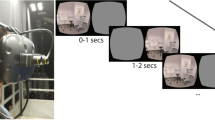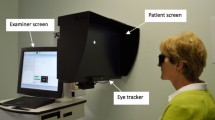Abstract
Background/Objectives
To propose a novel smart glasses device for recording eye movement and compare its results to the prism alternate cover test (PACT).
Subjects/Methods
This method comparison study enrolled patients with strabismic conditions, who first underwent conventional strabismus evaluations (PACT in the primary position), followed by the smart glasses NeuroSpeed system (NSS) recording protocols. The video recordings were analysed using specialized software, to calculate the horizontal deviation from the primary position. The results were compared with those of the PACT using Passing‒Bablok regression and Bland‒Altman analysis.
Results
This study included 70 individuals aged 4 to 80 years, of which 38 were men and 32 were women. The overall analysis of horizontal deviations using the Passing‒Bablok regression revealed a correlation coefficient (r) of 0.969, with a systemic bias of 0.00, a proportional bias of 0.809, and a perpendicular residual standard deviation of 4.134.
Conclusions
The predictive values of eye movement examinations recorded by the NSS were comparable to those of the PACT. Thus, this new system can provide additional information for ophthalmologists to aid in the diagnosis and measurement of strabismus.
This is a preview of subscription content, access via your institution
Access options
Subscribe to this journal
Receive 18 print issues and online access
$259.00 per year
only $14.39 per issue
Buy this article
- Purchase on Springer Link
- Instant access to full article PDF
Prices may be subject to local taxes which are calculated during checkout


Similar content being viewed by others
Data availability
The datasets generated during and/or analysed during the current study are available from the corresponding author on reasonable request.
References
Li JPO, Liu H, Ting DSJ, Jeon S, Chan RVP, Kim JE, et al. Digital technology, tele-medicine and artificial intelligence in ophthalmology: a global perspective. Vol. 82, Progress in Retinal and Eye Research. Elsevier Ltd; 2021.
Kim SE, Logeswaran A, Kang S, Stanojcic N, Wickham L, Thomas P, et al. Digital Transformation in Ophthalmic Clinical Care during the COVID-19 Pandemic. Vol. 10, Asia-Pacific Journal of Ophthalmology. Lippincott Williams and Wilkins; 2021. p. 381–7.
de Jongh E, Leach C, Tjon-Fo-Sang MJ, Bjerre A. Inter-examiner variability and agreement of the alternate prism cover test (APCT) measurements of strabismus performed by 4 examiners. Strabismus. 2014;22:158–66.
Holmes JM, Chandler DL, Christiansen SP, Birch EE, Bothun E, Laby D, et al. Interobserver reliability of the prism and alternate cover test in children with esotropia. Arch Ophthalmol [Internet]. 2009;127:59. http://archopht.jamanetwork.com/article.aspx?doi=10.1001/archophthalmol.2008.548.
Schutte S, Polling JR, van der Helm FCT, Simonsz HJ. Human error in strabismus surgery: quantification with a sensitivity analysis. Graefe’s Arch Clin Exp Ophthalmol. 2009;247:399–409.
Cheng W, Lynn MH, Pundlik S, Almeida C, Luo G, Houston K. A smartphone ocular alignment measurement app in school screening for strabismus. BMC Ophthalmol. 2021;21:150.
Pundlik S, Tomasi M, Liu R, Houston K, Luo G. Development and preliminary evaluation of a smartphone app for measuring eye alignment. Transl Vis Sci Technol. 2019;8:19.
Yehezkel O, Belkin M, Wygnanski-Jaffe T. Automated diagnosis and measurement of strabismus in children. Am J Ophthalmol. 2020;213:226–34.
Yeh PH, Liu CH, Sun MH, Chi SC, Hwang YS. To measure the amount of ocular deviation in strabismus patients with an eye-tracking virtual reality headset. BMC Ophthalmol. 2021;21:246.
Mao K, Yang Y, Guo C, Zhu Y, Chen C, Chen J, et al. An artificial intelligence platform for the diagnosis and surgical planning of strabismus using corneal light-reflection photos. Ann Transl Med. 2021;9:374–74.
Phanphruk W, Liu Y, Morley K, Gavin J, Shah AS, Hunter DG. Validation of strabis PIX, a mobile application for home measurement of ocular alignment. Transl Vis Sci Technol. 2019;8:9.
Valente TLA, de Almeida JDS, Silva AC, Teixeira JAM, Gattass M. Automatic diagnosis of strabismus in digital videos through cover test. Comput Methods Prog Biomed [Internet]. 2017;140:295–305. https://doi.org/10.1016/j.cmpb.2017.01.002.
Weber KP, Rappoport D, Dysli M, Schmückle Meier T, Marks GB, Bockisch CJ, et al. Strabismus measurements with novel video goggles. Ophthalmol [Internet]. 2017;124:1849–56. https://doi.org/10.1016/j.ophtha.2017.06.020.
Chen ZH, Fu H, Lo WL, Chi Z, Xu B. Eye-tracking-aided digital system for strabismus diagnosis. Health Technol Lett. 2018;5:1–6.
Chen Z, Fu H, Lo WL, Chi Z. Eye-tracking aided digital system for strabismus diagnosis. Proc - 2015 IEEE Int Conf Syst Man Cybern SMC. 2015;2016:2305–9.
Miao Y, Jeon JY, Park G, Park SW, Heo H. Virtual reality-based measurement of ocular deviation in strabismus. Comput Methods Prog Biomed. 2020;185:105132.
Yang HK, Seo JM, Hwang JM, Kim KG. Automated analysis of binocular alignment using an infrared camera and selective wavelength filter. Invest Ophthalmol Vis Sci. 2013;54:2733–7.
von Noorden GK, Campos EC (Emilio C). Binocular vision and ocular motility: theory and management of strabismus. Mosby; 2002. p. 653.
Roper-Hall G. The Hess Screen Test. Am Orthoptic J. [Internet] 2006;56:166–74. https://www.tandfonline.com/doi/full/10.3368/aoj.56.1.166.
Lancaster WB. Detecting, measuring, plotting and interpreting ocular deviations. Arch Ophthalmol [Internet]. 1939;22:867–80. http://archopht.jamanetwork.com/article.aspx?articleid=614661.
Christoff A, David COT, Guyton L. The lancaster red-green test. Am Orthopt J. 2006;56:157–65.
Watts P, Nayak H, Lim MK, Ashcroft A, al Madfai H, Palmer H. Validity and ease of use of a computerized Hess chart. J AAPOS. 2011;15:451–4.
Bergamin O, Zee DS, Roberts DC, Landau K, Lasker AG, Straumann D. Three-dimensional Hess screen test with binocular dual search coils in a three-field magnetic system. Invest Ophthalmol Vis Sci [Internet]. 2001;42:660–7. http://www.ncbi.nlm.nih.gov/pubmed/11222524.
Roodhooft JM. Screen tests used to map out ocular deviations. Bull Soc Belg Ophtalmol [Internet]. 2007;305:57–67. http://www.ncbi.nlm.nih.gov/pubmed/18018429.
Holmes JM, Leske DA, Hohberger GG. Defining real change in prism-cover test measurements. Am J Ophthalmol. 2008;145:381–5.
Hatt SR, Leske DA, Liebermann L, Mohney BG, Holmes JM. Variability of angle of deviation measurements in children with intermittent exotropia. J AAPOS. 2012;16:120–4.
Neveu P, Priot AE, Plantier J, Roumes C. Short exposure to telestereoscope affects the oculomotor system. Ophthalmic Physiol Opt. 2010;30:806–15.
Acknowledgements
We wish to thank the research team of Neurobit Technologies Co., Ltd (Chun-Chen Yang, Wei-Cheng Chen, Chin-Hsun Huang, and Ching-Fu Wang) for the development of the NeuroSpeed system (Ophthalmic version).
Funding
This research was funded by the MOST (Ministry of Science and Technology) (MOST 110-2314-B-016-051 and MOST 111-2314-B-016-035), TSGH (Tri-Service General Hospital) (TSGH-D-109190 and TSGH-D-110111) and Ministry of National Defense Medical Affairs Bureau (MND-MAB-C-11105-111019 and MND-MAB-C14-112057).
Author information
Authors and Affiliations
Contributions
Design of the study (KC) and conduct of the study (KC); data collection (KF, LL), data analysis (PC, LL), and interpretation of the data (KF, LL, KC); and preparation (YC), review (KC), and approval of the manuscript (KC, YC).
Corresponding author
Ethics declarations
Competing interests
The authors declare no competing interests.
Additional information
Publisher’s note Springer Nature remains neutral with regard to jurisdictional claims in published maps and institutional affiliations.
Supplementary information
Rights and permissions
Springer Nature or its licensor (e.g. a society or other partner) holds exclusive rights to this article under a publishing agreement with the author(s) or other rightsholder(s); author self-archiving of the accepted manuscript version of this article is solely governed by the terms of such publishing agreement and applicable law.
About this article
Cite this article
Lee, LC., Feng, K.M., Chuang, PC. et al. Preliminary data on a novel smart glasses system for measuring the angle of deviation in strabismus. Eye 37, 2700–2706 (2023). https://doi.org/10.1038/s41433-023-02402-5
Received:
Revised:
Accepted:
Published:
Issue Date:
DOI: https://doi.org/10.1038/s41433-023-02402-5



